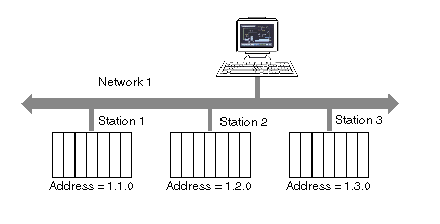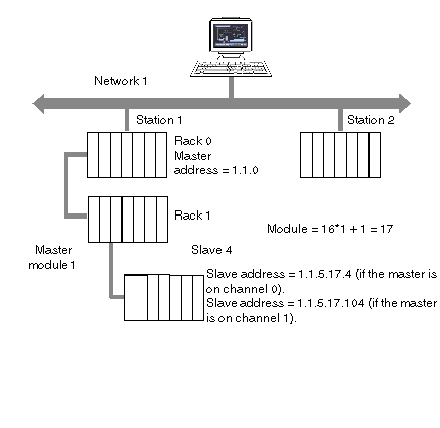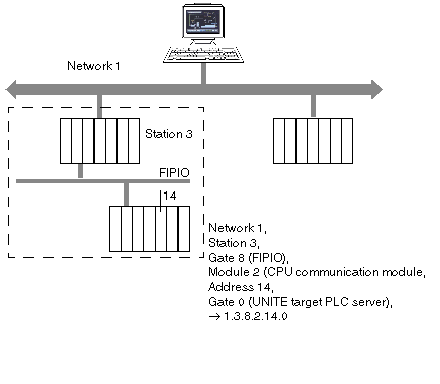Example of access through a network:
Addressing to 3 levels:
Allows a station connected to the network at any point of the X-Way communication architecture to be reached.
Illustration:
The Network and Station values make up the station address.
The value "Gate" refers to the communication entity within the station: system server (Gate 0, the most common), the terminal port (Gates 1,2,3), 1K asynchronous server (Gate 7), etc.
In the case of multiprocessor stations such as PLCs, each processor module built into the system can support communication entities, frame routing requiring supplementary addressing levels (inter-station routing capabilities). PLC "processor modules" are situated in the PLC's racks or offset on field buses.
Addressing to 5 levels:
It is generally used for devices connected on a Uni-Telway bus.
Illustration:
-
Module: physical location of the communication module in the rack. Its value must be defined as follows: (Master rack number * 16) + Number of master module.
-
Channel: address of the device connected to the communication module. Its value must be defined as follows: (Master channel number * 100) + slave Ad0 number.
Addressing to 6 levels:
This is similar to addressing to 5 levels. It was created for extended services (FIPIO, communication module integrated in rack).
Illustration:
-
Selector: designates a communication module on the CPU (2) or in a separate module (1).
-
Connection point: device address, if the destination module is FIPIO. Physical positioning in the PLC rack, if the destination module is a PLC card.
-
Reference: communication entity in the device (similar to the Gate number).
Examples:
5 level addressing:
6 level addressing:
For more information on the X-Way address, see "X-Way Communication" documentation, ref. TSX DR NET.
NOTE: In point to point connections (Uni-Telway, ISAway, PCIway), the default address 0.254.0 can be used to reference the PLC.
0.254.0 can be used to access to the Fipio Master when we are connected through the privilegied terminal @63
0.254.5.17.104 can be used to access to the Uni-Telway slave @4 which is connected on the rack 1 module 1 channel 1 when we are connected on the local PLC.
0.254.8.2.14.0 can be used to access to the Fipio connection point 14 when we are connected through the privilegied terminal @63.
With Ethway and XIP, it is possible to use gate 7, which accepts large frames (up to 1024 bytes). In order to do this, the PL7 application must be configured in periodic mode (MAST task). The "1K service" option must be checked in the alias definition page.
Example: normal address: XIP01:1.2, to use gate 7: XIP01:1.2.7





